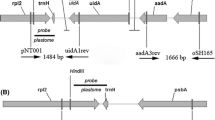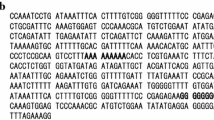Abstract
Expression of foreign proteins from transgenes incorporated into plastid genomes requires regulatory sequences that can be recognized by the plastid transcription and translation machinery. Translation signals harbored by the 5′ untranslated region (UTR) of plastid transcripts can profoundly affect the level of accumulation of proteins expressed from chimeric transgenes. Both endogenous 5′ UTRs and the bacteriophage T7 gene 10 (T7g10) 5′ UTR have been found to be effective in combination with particular coding regions to mediate high-level expression of foreign proteins. We investigated whether two other bacteriophage 5′ UTRs could be utilized in plastid transgenes by fusing them to the aadA (aminoglycoside-3′-adenyltransferase) coding region that is commonly used as a selectable marker in plastid transformation. Transplastomic plants containing either the T7g1.3 or T4g23 5′ UTRs fused to Myc-epitope-tagged aadA were successfully obtained, demonstrating the ability of these 5′ UTRs to regulate gene expression in plastids. Placing the Thermobifida fusca cel6A gene under the control of the T7g1.3 or T4g23 5′ UTRs, along with a tetC downstream box, resulted in poor expression of the cellulase in contrast with high-level accumulation while using the T7g10 5′ UTR. However, transplastomic plants with the bacteriophage 5′ UTRs controlling the aadA coding region exhibited fewer undesired recombinant species than plants containing the same marker gene regulated by the Nicotiana tabacum psbA 5′ UTR. Furthermore, expression of the T7g1.3 and T4g23 5′ UTR::aadA fusions downstream of the cel6A gene provided sufficient spectinomycin resistance to allow selection of homoplasmic transgenic plants and had no effect on Cel6A accumulation.








Similar content being viewed by others
Abbreviations
- 5′ UTR:
-
5′ Untranslated region
- AadA:
-
Aminoglycoside-3′-adenyltransferase
- DB:
-
Downstream box
- EPSPS:
-
5-Enolpyruvylshikimate-3-phosphate synthase
- GUS:
-
β-Glucuronidase
- IEE:
-
Intercistronic expression element
- PPR:
-
Pentatricopeptide repeat
- RPS1:
-
Ribosomal protein S1
- SD:
-
Shine-Dalgarno
- SSC:
-
Saline-sodium citrate
- T4g23:
-
T4 gene 23
- T7g10:
-
T7 gene 10
- T7g1.3:
-
T7 gene 1.3
- TetC:
-
Fragment C of tetanus toxin
- TSP:
-
Total soluble protein
References
Ahmad N, Michoux F, McCarthy J, Nixon PJ (2012) Expression of the affinity tags, glutathione-S-transferase and maltose-binding protein, in tobacco chloroplasts. Planta 235:863–871
Barkan A (2011) Expression of plastid genes: organelle-specific elaborations on a prokaryotic scaffold. Plant Physiol 155:1520–1532
Bohne AV, Ruf S, Borner T, Bock R (2007) Faithful transcription initiation from a mitochondrial promoter in transgenic plastids. Nucleic Acids Res 35:7256–7266
Boni IV, Isaeva DM, Musychenko ML, Tzareva NV (1991) Ribosome-messenger recognition: mRNA target sites for ribosomal protein S1. Nucleic Acids Res 19:155–162
Drechsel O, Bock R (2010) Selection of Shine-Dalgarno sequences in plastids. Nucleic Acids Res 39:1427–1438
Fargo DC, Zhang M, Gillham NW, Boynton JE (1998) Shine-Dalgarno-like sequences are not required for translation of chloroplast mRNAs in Chlamydomonas reinhardtii chloroplasts or in Escherichia coli. Mol Gen Genet 257:271–282
Gray BN, Ahner BA, Hanson MR (2009a) Extensive homologous recombination between introduced and native regulatory plastid DNA elements in transplastomic plants. Transgenic Res 18:559–572
Gray BN, Ahner BA, Hanson MR (2009b) High-level bacterial cellulase accumulation in chloroplast-transformed tobacco mediated by downstream box fusions. Biotechnol Bioeng 102:1045–1054
Gray BN, Yang H, Ahner BA, Hanson MR (2011) An efficient downstream box fusion allows high-level accumulation of active bacterial beta-glucosidase in tobacco chloroplasts. Plant Mol Biol 76:345–355
Herz S, Fussl M, Steiger S, Koop HU (2005) Development of novel types of plastid transformation vectors and evaluation of factors controlling expression. Transgenic Res 14:969–982
Hirose T, Sugiura M (2004) Multiple elements required for translation of plastid atpB mRNA lacking the Shine-Dalgarno sequence. Nucleic Acids Res 32:3503–3510
Kim J, Mullet JE (1994) Ribosome-binding sites on chloroplast rbcL and psbA mRNAs and light-induced initiation of D1 translation. Plant Mol Biol 25:437–448
Kuroda H, Maliga P (2001a) Complementarity of the 16S rRNA penultimate stem with sequences downstream of the AUG destabilizes the plastid mRNAs. Nucleic Acids Res 29:970–975
Kuroda H, Maliga P (2001b) Sequences downstream of the translation initiation codon are important determinants of translation efficiency in chloroplasts. Plant Physiol 125:430–436
Kuroda H, Maliga P (2002) Overexpression of the clpP 5′-untranslated region in a chimeric context causes a mutant phenotype, suggesting competition for a clpP-specific RNA maturation factor in tobacco chloroplasts. Plant Physiol 129:1600–1606
Li Y, Gou M, Sun Q, Hua J (2010) Requirement of calcium binding, myristoylation, and protein–protein interaction for the Copine BON1 function in Arabidopsis. J Biol Chem 285:29884–29891
Maliga P (2004) Plastid transformation in higher plants. Annu Rev Plant Biol 55:289–313
Maliga P, Bock R (2011) Plastid biotechnology: food, fuel, and medicine for the 21st century. Plant Physiol 155:1501–1510
Moll I, Grill S, Gualerzi CO, Blasi U (2002) Leaderless mRNAs in bacteria: surprises in ribosomal recruitment and translational control. Mol Microbiol 43:239–246
Mutsuda M, Sugiura M (2006) Translation initiation of cyanobacterial rbcS mRNAs requires the 38-kDa ribosomal protein S1 but not the Shine-Dalgarno sequence: development of a cyanobacterial in vitro translation system. J Biol Chem 281:38314–38321
Nakagawa S, Niimura Y, Miura K, Gojobori T (2010) Dynamic evolution of translation initiation mechanisms in prokaryotes. Proc Natl Acad Sci USA 107:6382–6387
Oey M, Lohse M, Kreikemeyer B, Bock R (2009a) Exhaustion of the chloroplast protein synthesis capacity by massive expression of a highly stable protein antibiotic. Plant J 57:436–445
Oey M, Lohse M, Scharff LB, Kreikemeyer B, Bock R (2009b) Plastid production of protein antibiotics against pneumonia via a new strategy for high-level expression of antimicrobial proteins. Proc Natl Acad Sci USA 106:6579–6584
Olins PO, Devine CS, Rangwala SH, Kavka KS (1988) The T7 phage gene 10 leader RNA, a ribosome-binding site that dramatically enhances the expression of foreign genes in Escherichia coli. Gene 73:227–235
Peled-Zahavi H, Danon A (2007) Translation and translational regulation in chloroplasts. In: Bock R (ed) Cell and molecular biology of plastids. Springer, Berlin Heidelberg, pp 249–281
Plader W, Sugiura M (2003) The Shine-Dalgarno-like sequence is a negative regulatory element for translation of tobacco chloroplast rps2 mRNA: an additional mechanism for translational control in chloroplasts. Plant J 34:377–382
Reddy VS, Leelavathi S, Selvapandiyan A, Raman R, Giovanni F, Shukla V, Bhatnagar RK (2002) Analysis of chloroplast transformed tobacco plants with cry1Ia5 under rice psbA transcriptional elements reveal high level expression of Bt toxin without imposing yield penalty and stable inheritance of transplastome. Mol Breeding 9:259–269
Sprengart ML, Fatscher HP, Fuchs E (1990) The initiation of translation in E. coli: apparent base pairing between the 16srRNA and downstream sequences of the mRNA. Nucleic Acids Res 18:1719–1723
Sprengart ML, Fuchs E, Porter AG (1996) The downstream box: an efficient and independent translation initiation signal in Escherichia coli. EMBO J 15:665–674
Staub JM, Maliga P (1993) Accumulation of D1 polypeptide in tobacco plastids is regulated via the untranslated region of the psbA mRNA. EMBO J 12:601–606
Staub JM, Garcia B, Graves J, Hajdukiewicz PT, Hunter P, Nehra N, Paradkar V, Schlittler M, Carroll JA, Spatola L, Ward D, Ye G, Russell DA (2000) High-yield production of a human therapeutic protein in tobacco chloroplasts. Nat Biotechnol 18:333–338
Studier FW, Rosenberg AH, Simon MN, Dunn JJ (1979) Genetic and physical mapping in the early region of bacteriophage T7 DNA. J Mol Biol 135:917–937
Svab Z, Maliga P (1993) High-frequency plastid transformation in tobacco by selection for a chimeric aadA gene. Proc Natl Acad Sci U S A 90:913–917
Tregoning JS, Nixon P, Kuroda H, Svab Z, Clare S, Bowe F, Fairweather N, Ytterberg J, van Wijk KJ, Dougan G, Maliga P (2003) Expression of tetanus toxin Fragment C in tobacco chloroplasts. Nucleic Acids Res 31:1174–1179
Young ET, Menard RC, Harada J (1981) Monocistronic and polycistronic bacteriophage T4 gene 23 messages. J Virol 40:790–799
Yukawa M, Kuroda H, Sugiura M (2007) A new in vitro translation system for non-radioactive assay from tobacco chloroplasts: effect of pre-mRNA processing on translation in vitro. Plant J 49:367–376
Zhou F, Karcher D, Bock R (2007) Identification of a plastid intercistronic expression element (IEE) facilitating the expression of stable translatable monocistronic mRNAs from operons. Plant J 52:961–972
Acknowledgments
We thank Prof. David Wilson (Cornell University) for the anti-Cel6A antibody. BNG was the recipient of a National Science Foundation Graduate Research Fellowship. This work was supported by a USDA Grant (USDA NRI 2007-02133) to BAA and MRH. This research was also supported in part by the Cornell University Agricultural Experiment Station federal formula funds, Project No. NYC-165425 received from Cooperative State Research, Education and Extension Service, US Department of Agriculture. Any opinions, findings, conclusions, or recommendations expressed in this publication are those of the author(s) and do not necessarily reflect the view of the US Department of Agriculture.
Author information
Authors and Affiliations
Corresponding author
Additional information
A contribution to the Special Issue on Evolution and Biogenesis of Chloroplasts and Mitochondria.
Rights and permissions
About this article
Cite this article
Yang, H., Gray, B.N., Ahner, B.A. et al. Bacteriophage 5′ untranslated regions for control of plastid transgene expression. Planta 237, 517–527 (2013). https://doi.org/10.1007/s00425-012-1770-3
Received:
Accepted:
Published:
Issue Date:
DOI: https://doi.org/10.1007/s00425-012-1770-3




